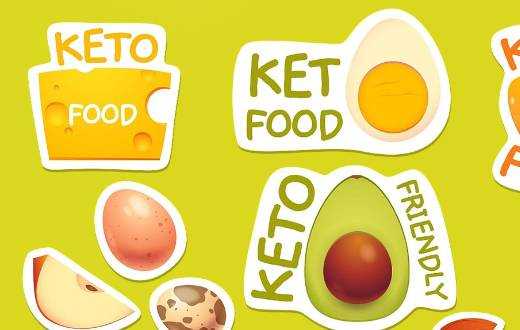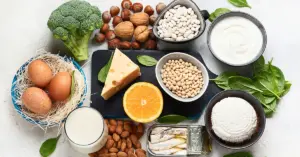The ketogenic, or keto, diet has gained significant popularity over the years as a weight-loss strategy and a way to manage certain health conditions.
This diet primarily focuses on high-fat, moderate-protein, and low-carbohydrate foods, challenging the conventional dietary norm.
As such, for those on a ketogenic diet, many staple foods – such as bread, rice, and noodles – typically high in carbohydrates, must be severely limited or altogether avoided.
However, a diet’s success often hinges on its sustainability, and who wants to say no to noodles forever?
Thankfully, food innovation and dietary creativity have come a long way. Now, even for the strict keto dieters, a plethora of alternatives to high-carb foods exist.
This article specifically explores the realm of keto-friendly noodles – low-carb substitutes for the traditional pasta we all love.
These alternatives not only help you keep your carb count low but also add variety and nutrition to your meals.
From vegetables spiralized into noodle-like shapes to unique creations like shirataki noodles, and even high-protein noodles crafted from ingredients like tofu, there are numerous options to satisfy your noodle cravings while staying within your ketogenic goals.
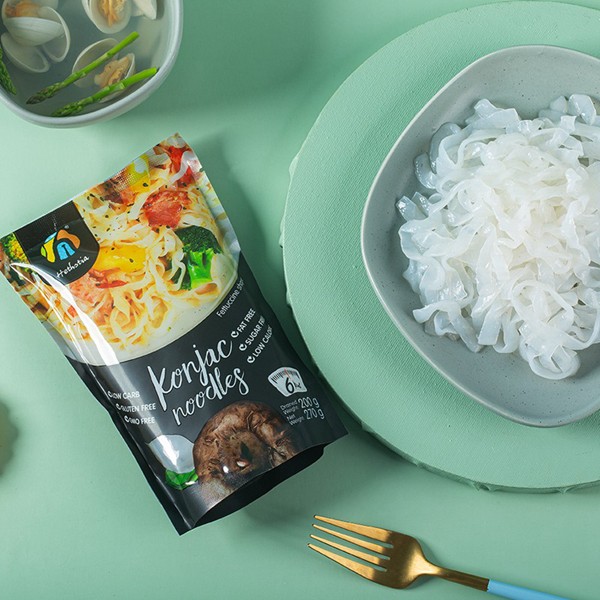
In the sections that follow, we will dive into the world of keto-friendly noodles, examining their nutritional values, especially net carbs, preparation methods, and uses in various culinary delights.
So, whether you’re a seasoned keto dieter a newbie starting your low-carb journey, or just want to avoid carbohydrates, this guide aims to show you that a keto lifestyle doesn’t mean bidding farewell to delicious, comforting noodles.
Instead, it’s an opportunity to discover and enjoy a whole new array of noodle alternatives that are as tasty as they are nutritious. Let’s start this culinary adventure together!
Why Net Carb is so Important in the Keto Diet?
One of the cornerstones of the ketogenic diet is managing the intake of net carbs. But what are net carbs, and why are they important?
Net carbs are simply the total carbohydrates in a food minus its fiber content.
This calculation is based on the fact that fiber, while technically a carbohydrate, is not absorbed or processed the same way as other carbs in the body.
Fiber passes through the digestive system largely undigested, hence it doesn’t contribute to the rise in blood sugar levels that other carbs often cause.
Therefore, when you’re counting carbs on a keto diet, you’re counting net carbs.
Why does this matter?
The ketogenic diet works by pushing the body into a metabolic state called ketosis, where it burns fat for fuel instead of glucose.
To reach and maintain ketosis, one must limit their carbohydrate intake, usually to under 20-50g net carbs per day, although this can vary based on individual factors.
Exceeding this limit can knock the body out of ketosis, making it crucial for those on a keto diet to monitor their net carb intake carefully.
This brings us to noodles, a beloved staple food in many cuisines.
Traditional noodles are typically high in carbohydrates and low in fiber, giving them a high net carb count. This makes them unsuitable for a keto diet.
However, many alternatives provide the satisfaction of noodles without the excessive net carbs. In the next section, we will introduce a variety of keto-friendly noodles, highlighting their net carb content and unique characteristics.
With this guide, you can enjoy your favorite noodle dishes while staying committed to your keto lifestyle.
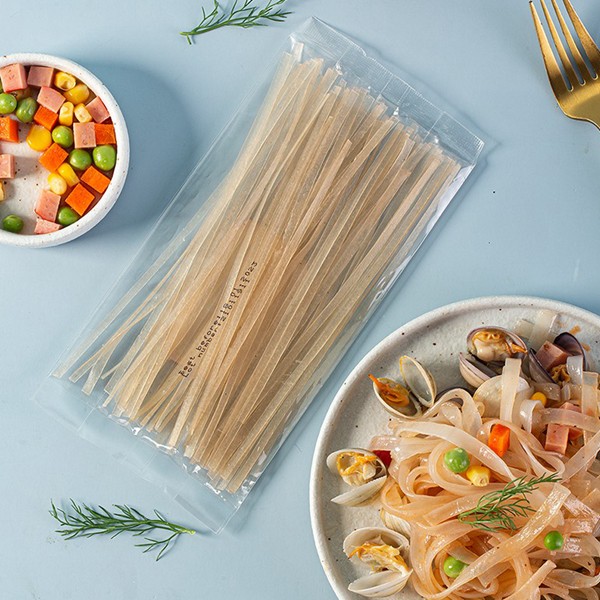
A Guide to Keto-Friendly Noodles
Navigating through the world of noodles while on a ketogenic diet can seem challenging. But, with the right information and a variety of options at hand, it becomes an adventurous culinary journey. Let’s dive into the world of keto-friendly noodles, examining their nutritional profiles and unique attributes:
Shirataki Noodles: Net Carbs per 100g: 0-1g
Also known as konjac noodles, shirataki noodles are made from the fiber of the konjac plant. Their virtually carb-free and low-calorie nature makes them a popular choice for keto dieters. The noodles are gelatinous in texture and absorb flavors well, making them a versatile addition to many dishes.
Immi Ramen: Net Carbs per 100g: 8g
This innovative brand offers plant-based, instant ramen noodles designed to be keto-friendly. They are higher in protein and fiber than many alternatives, while being low in carbs.
Hearts of Palm Noodles: Net Carb per 100g: 2-4g
Derived from the inner portion of palm trees, these noodles offer a texture akin to regular pasta. They are low in carbs and calories, making them a viable choice for keto dieters.
Kohlrabi Noodles: Net Carb per 100g: 6-8g
Kohlrabi, a turnip-like vegetable, can be spiralized into noodle form. Slightly more carb-dense than some vegetable noodles, they can still fit into a ketogenic diet in moderation.
Zoodles (Zucchini Noodles): Net Carb per 100g: 2-3g
Made by spiralizing zucchini into thin, noodle-like strips, zoodles are low in carbs and calories. They are highly versatile and pair well with a variety of sauces.
Spaghetti Squash: Net Carbs per 100g: 5-6g
When cooked, the inside of spaghetti squash transforms into noodle-like strands. Although slightly higher in carbs compared to zoodles, it remains keto-friendly in moderate amounts.
Cucumber Noodles: Net Carbs per 100g: 2-3g
Made by spiralizing cucumber, these noodles offer a refreshing, crisp alternative. They are very low in carbs and calories.
Kelp Noodles: Net Carbs per 100g: 1-2g
Kelp noodles, derived from seaweed, are low in carbs and calories. With a unique, slightly crunchy texture, they add an interesting twist to meals.
Egg Noodles: Net Carbs per 100g: 3-4g
Created from egg and cream cheese, these noodles are a higher-protein alternative and make a fantastic low-carb substitute.
Butternut Squash Noodles: Net Carbs per 100g: 9-10g
While higher in carbs than zucchini, butternut squash noodles can still be included in a keto diet in moderation.
Cabbage Noodles: Net Carbs per 100g: 3-4g
Thinly sliced cabbage can be used as a low-carb noodle substitute. A versatile and nutrient-dense option.
Chicken Noodles: Net Carbs per 100g: 0g
For virtually carb-free and high-protein noodles, some creative recipes offer ways to make noodles out of chicken.
Tofu Noodles: Net Carbs per 100g: 3-5g
Certain brands offer noodles made from tofu. These tend to be lower in carbs and higher in protein.
Edamame Noodles: Net Carbs per 100g: 13-15g
Made from young soybeans, these noodles are higher in protein and fiber than traditional pasta.
Black Bean Noodles: Net Carbs per 100g: 20-25g
High in protein and fiber, black bean noodles are higher in net carbs than many other keto-friendly alternatives.
Each of these noodle alternatives offers a unique flavor and texture profile, providing a wonderful range of options for those on a ketogenic diet.
In the following section, we will explore how to incorporate these noodles into your diet in tasty and satisfying ways.
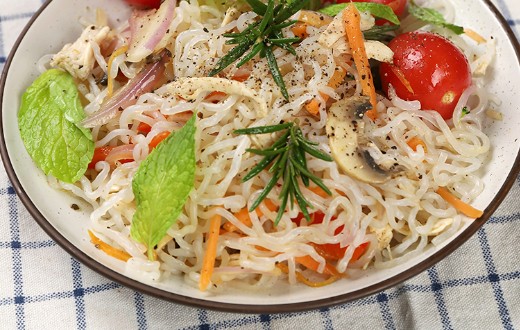
How to Incorporate These Noodles into Your Diet
Adopting keto-friendly noodles into your meals is a journey of discovery and creativity.
With the variety available, you can experiment with flavors, textures, and preparation methods. Here are some tips on how to incorporate these noodle substitutes into your ketogenic diet:
-
- Experiment with sauces and toppings: Whether it’s a creamy Alfredo, a spicy Arrabbiata, or a rich Bolognese, your choice of sauce can transform your keto-friendly noodles. Add a sprinkle of cheese or a handful of fresh herbs to enhance the flavor even further.
-
- Protein Pairings: Pair your noodles with keto-friendly protein sources like chicken, beef, or tofu for a balanced and satisfying meal.
-
- Try different cooking methods: Depending on the noodle alternative, you can try boiling, sautéing, or even baking. For example, baking spaghetti squash brings out its sweetness, while sautéing zoodles keeps them crisp.
-
- Pay attention to portions: While these noodle substitutes are lower in carbs, they still contain some level of carbohydrates. Be mindful of your portion sizes to stay within your daily carb limit.
-
- Meal Prep: Many of these noodles can be prepped in advance. For example, you can spiralize zucchini or kohlrabi ahead of time, or pre-cook and refrigerate your shirataki noodles.

Where to Buy Keto-Friendly Noodles
Locating keto-friendly noodles may seem daunting initially, but many are more readily available than you might think.
-
- Grocery Stores: Check the produce section of your local supermarket for fresh vegetable noodles like zoodles or kohlrabi noodles. The tofu or Asian food section may have shirataki noodles, tofu noodles, and kelp noodles. Hearts of Palm noodles might be found with the canned vegetables.
-
- Health Food Stores: Specialty health food stores often carry a wider variety of low-carb alternatives, including various keto-friendly noodles.
-
- Online Shopping: Online retailers like Amazon or specific brand websites offer an extensive range of keto-friendly noodles that you can have delivered to your doorstep.
-
- Farmers’ Markets: Local farmers’ markets can be a great source of fresh, organic vegetables suitable for making your own vegetable noodles.
Remember, it’s important to read and understand the nutritional labels when shopping for these products. Watch for added sugars or other high-carb ingredients that could increase the net carb count.
With these resources at your disposal, the world of keto-friendly noodles is easier to navigate than ever.
The journey may be challenging at first, but once you get the hang of it, you’ll realize that the keto diet doesn’t limit your options – it simply opens up a whole new array of possibilities. Happy noodle hunting!

